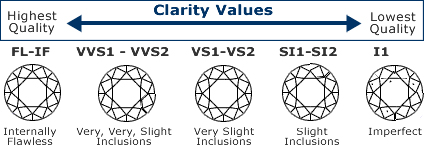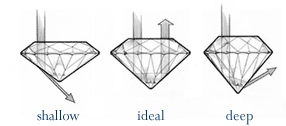 |
 |
 |
|
| THE 4 C'S OF DIAMONDS |
|
| 1) Color |
|
Color describes the amount of color the diamond contains. This can range from colorless to yellow with slight tints of yellow, gray or brown.
Colors can also range from intense yellow to brown, blue, green, pink and red. These fancy colors are rare and therefore more valuable.
|
|
 |
|
 |
 |
 |
 |
 |
| GIA |
COLOR - COMMERCIAL GRADING |
 |
 |
D
E
F |
Colorless
(White) |
 |
 |
G
H
I
J |
Near
Colorless
(White) |
 |
 |
K
L
M |
Faint
Yellow |
 |
 |
| N,O,P,Q,R |
Very
Light Yellow |
 |
 |
S,T,U,V,
W,X,Y,Z |
Light
Yellow |
 |
 |
|
|
| 2) Clarity |
|
Clarity describes the clearness or purity of a diamond. This is determined by the number, size, nature, and location of the internal (inclusions) and external (blemishes) imperfections.
|
|
 |
|
 |
 |
 |
 |
 |
 |
 |
| Symbol |
Meaning |
Definition |
 |
 |
 |
| F |
Flawless |
Free from all
inclusions or blemishes. |
 |
 |
 |
| IF |
Internally Flawless |
No inclusions
visible at 10x magnification. |
 |
 |
 |
| VVS1 |
Very Very Slightly
Included #1 |
Inclusions that are
extremely difficult to locate at 10x. |
 |
 |
 |
| VVS2 |
Very Very Slightly
Included #2 |
Inclusions that are
very difficult to locate at 10x. |
 |
 |
 |
| VS1 |
Very Slightly
Included #1 |
Minor inclusions
that are difficult to locate at 10x. |
 |
 |
 |
| VS2 |
Very Slightly
Included #2 |
Minor inclusions
that are somewhat difficult to locate at 10x. |
 |
 |
 |
| SI1 |
Slightly Included
#1 |
Noticeable
inclusions that are easy to locate at 10x. |
 |
 |
 |
| Sl2 |
Slightly Included
#2 |
Noticeable
inclusion that are very easy to locate at 10x. |
 |
 |
 |
| I1 |
Included #1 |
Obvious inclusions.
Somewhat easy to locate with the unaided eye. |
 |
 |
 |
| I2 |
Included #2 |
Obvious inclusions.
Easy to locate with the unaided eye. |
 |
 |
 |
| I3 |
Included #3 |
Obvious inclusions.
Very easy to locate with the unaided eye. |
 |
 |
 |
|
|
| 3) Cut |
Cut refers to the proportions, finish, symmetry, and polish of the diamond. These factors determine the fire and brilliance of a diamond. Well cut diamonds sell at a premium and poorly cut diamonds sell at discounted prices. With the advent of technology, the cut of the diamond can be determined through the use of the Dia-Mension system, a computerized system which takes accurate measurements and proportions of a diamond in seconds, in addition to the standard millimeter gauge.
As an example, a round brilliant cut, which has 58 facets, is shown below. Since the quality of the cut is directly responsible for the stone's beauty, the precision with which the facets are arranged is of prime importance. They determine the amount of light reflected to the eye, called brilliance.
The proportions displayed by the stone are very significant. Two of the key factors in the grading of cut quality -- table percentage and depth percentage -- are usually expressed on grading reports. Measurement of three different parameters allows for easy calculation of these percentages by using the formulas expressed below.
|
|
 |
|
|
|
|
| 4) Carat Weight |
|
Carat Weight is the unit of weight for the diamond. A carat is further subdivided in 100 points ( 0.01 carat = l point ). One carat is equal to 0.20 grams. Value per carat increases with carat size, because larger rough diamonds occur less frequently. In other words, 2 half-carat diamonds taken together will not cost as much as 1 one-carat diamond, as the one-carat stone is more rare.
|
|
|
 |
 |
|

|
|
Copyright © 2025 Salico Gem Corporation. All Rights Reserved.
Salico Gem Corporation and all respective logos are trademarks of Salico Gem Corporation.
Use of this website signifies your agreement to the and
|
Created by
|
|
|
|